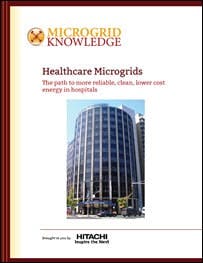Too many hospitals are unaware that they do not need to dive into their capital to install a healthcare microgrid, as we explain in the fifth article in our series on the healthcare microgrid.
Download the full report now
Given today’s uncertainties about healthcare policy in the United States, hospitals are understandably wary of making large capital investments. And those that do are likely to focus on projects that directly address their core mission – serving patients.
Upgrades to energy facilities tend to take a back seat. This is unfortunate because older, inefficient energy systems use more energy than is necessary, so hospital energy bills are higher than they should be.
Relying on inefficient energy equipment is a bit like putting your savings in a bank where interest rates are low. You could be making more money in a higher, yet guaranteed, yield investment fund. The longer you keep your money in the low-yield account, the greater your lost earnings over time.
Similarly, the longer a hospital puts off energy infrastructure upgrades, the larger the gap grows between what it should spend and what it does spend on energy— at least if electricity prices continue to rise as they have historically. The added operating expense reflects poorly on the hospital management when its performance is benchmarked against hospitals that have achieved more favorable budgeting through energy savings.
Most unfortunate, too many hospitals are unaware that they do not need to dive into their capital to install a healthcare microgrid. A practical alternative exists known as a no-money down microgrid.
This is achieved through use of a power purchase agreement (PPA), a contract structure used successfully for decades in various kinds of energy transactions. Under a healthcare microgrid PPA, the developer finances the risk and provides the upfront costs, and also operates and maintains the microgrid and its generators, so that the hospital can focus on its core work.
[clickToTweet tweet=”A no money down #microgrid is achieved through a power purchase agreement. ” quote=”A no money down #microgrid is achieved through a power purchase agreement. “]
The energy developer and hospital share the savings achieved by the microgrid over the lifetime of the equipment, typically about 20 years. Meanwhile, the hospital pays only for the energy it uses, which is billed at regular intervals, much the same way a utility invoices the hospital.
Most importantly, the contract is structured so the hospital energy cost stays low over time.
“If your hospital is located in an area of the country where energy prices are high —such as the Northeast and California—and you structure the microgrid agreement right, you can achieve an immediate return on investment and larger return over time,” Pullins said.
But, he added that favorable microgrid economics are not confined to these regions. “Bankability can occur wherever electricity prices for commercial customers exceed the national average.”
How a healthcare microgrid achieves a wedge of savings
Instead of experiencing growing losses, the hospital can achieve savings that expand over time. As Pullins explains, microgrids offer the opportunity for the hospital to achieve a “wedge of savings” that widens as years pass. This wedge develops based on both long and short-term financial strategies employed by the microgrid’s software and analytics.
Over the long term, the wedge grows as utility electricity prices rise and microgrid costs remain relatively stable. Electricity rates tend to go up as utilities upgrade and expand their infrastructure, particularly their power plants and vast transmission and distribution systems. Utilities also must assimilate any increases in fuel costs for their power plants. The microgrid is designed—via the generation resources it contains—to beat these price increases over the long term.
Over the short term, a microgrid can achieve cost advantage as electricity prices fluctuate throughout the day. The healthcare microgrid does this by using its own on-site energy, instead of relying on grid power, during the times of day when utility power is most expensive.
In fact, if the microgrid curtails its use of energy on the day and time when grid power is most expensive for the year, the hospital can achieve significant savings. This is because the utility determines what’s known as a hospital’s ‘demand charge’ for the year based on the price of power at that one point in time. The demand charge can represent a significant portion of a hospital’s annual energy bill, so it’s important to focus on reducing it.
A microgrid can also lower a hospital’s energy bills by incorporating solar energy, which requires no fuel. If the microgrid includes energy storage (often batteries), it stores the free solar energy and uses it to power the hospital when grid prices are high.
No two microgrids are alike; each is customized based on how the hospital uses energy, what energy resources are available, and other factors. Strategies for savings may also vary depending on the size and experience of the hospital’s energy partner. For example, because of its reach and scale Hitachi is able to negotiate lower prices for large volume use of natural gas for CHP. Pullins explains that this offers yet another cost-savings opportunity, a way to undercut fluctuating natural gas prices over time.
For every moment of the day, every day of the week, and every week of the year the controller fine-tunes resource use to achieve savings.
Bringing intelligence to the right resources
The sophistication of the microgrid controller also is likely to influence savings. An advanced controller can forecast immediate pricing and estimate long-term pricing, which allows it to activate the best combination of resources. The advanced microgrid controller optimizes its resources and leverages those assets against electricity grid prices at any given time. For every moment of the day, every day of the week, and every week of the year the controller fine-tunes resource use to achieve savings.
It’s important to note that it is through combined use of resources—solar, storage, CHP, utility power—that the microgrid achieves savings. Configured together correctly to respond to market conditions, demand charges, and weather changes, the resources can achieve greater savings.
By using solar, fuel management, demand charge reduction, and other optimization techniques, the microgrid can grow a hospital’s savings as utility rates rise. “So you may have five percent year one savings on your energy bill. But then out there at year 10 it is 10 or 15 percent. And at year 20 it is 25 percent. So you get a wedge of savings over time.” – Steve Pullins, vice president of energy solutions at Hitachi America
Using CHP alone will not achieve this end, Pullins says, because CHP plants are not designed for what’s known as load-following—the ability to increase or decrease energy production quickly as hospital energy use fluctuates. CHP plants cannot be quickly slowed or stopped without creating wear and tear that reduces life-time operating capabilities. So in a healthcare microgrid, solar and energy storage together act as a quick ramping resource, while the CHP plant provides ‘baseload’—energy always on to power the majority of hospital systems.
Adding solar and storage to the mix allows the CHP plant to run when it can achieve its lowest cost per megawatt, lowest emissions level, and lowest maintenance requirement, Pullins says. The solar-fed energy storage system is the fastest, most flexible, load-following resource.
“If we’ve built our algorithm properly, we are eking out everything that we can, and we are doing that on a moment by moment basis,” he says.
Utility rates have historically risen over time, and forecasters predict they will continue to do so. By using solar, fuel management, demand charge reduction, and other optimization techniques, the microgrid can grow a hospital’s savings as utility rates rise. “So you may have five percent year one savings on your energy bill. But then out there at year 10 it is 10 or 15 per cent. And at year 20 it is 25 percent. So you get a wedge of savings over time,” Pullins says.
The bottom line for your healthcare facility—and society as a whole—is a dollar saved on energy is a dollar available for patient care.
For more on the healthcare microgrid, see the guide “HealthCare Microgrids: The Path to More Reliable, Clean, Lower Cost Energy in Hospitals,” downloadable free of charge courtesy of Hitachi.







